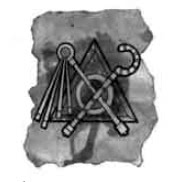Osiris
| Osiris | ||
|---|---|---|
 Crook and flail |
||
| Aliases | The White Crown | |
| Alignment | Lawful Good | |
| Divine Rank | 2E: Intermediate God 3E: Greater God |
|
| Pantheon | Egyptian, Mulhorandi | |
| Portfolio | Harvest, nature, the underworld | |
| Domains | 3E: Air, Earth, Good, Law, Plant, Repose 5E: Grave, Life, Nature |
|
| Home Plane | Great Wheel: Memphiria (Arcadia), Heliopolis) World Tree: Heliopolis |
|
| Worshippers | Farmers, monks, paladins, rangers | |
| Favoured Weapon | Flail | |
Osiris is an ancient Egyptian deity, the god of fertility, agriculture, the afterlife, the dead, resurrection, life, and vegetation; in particular he is associated with cycles observed in nature like the flooding of the Nile. He was classically depicted as a green-skinned deity with a pharaoh's beard, partially mummy-wrapped at the legs, wearing a distinctive atef crown, and holding a symbolic crook and flail. He was one of the first to be associated with the mummy wrap.
Family Tree[edit | edit source]
Osiris was at times considered the eldest son of the god Geb and the sky goddess Nut. Osiris is the brother and husband of Isis, Set, Nephthys, and Horus the Elder. He is father of Horus the Younger.
Historical Rites and rituals[edit | edit source]
Ikhernofret Stela[edit | edit source]
The stela of Ikhernofert is a limestone rock with some stuff about Osiris written on it:
The ritual reenactment of Osiris's funeral rites were held in the last month of the inundation (the annual Nile flood), coinciding with Spring, and held at Abydos which was the traditional place where the body of Osiris drifted ashore after having been drowned in the Nile.
The part of the myth recounting the chopping up of the body into 14 pieces by Set is not recounted in this particular stela. Although it is attested to be a part of the rituals by a version of the Papyrus Jumilhac, in which it took Isis 12 days to reassemble the pieces, coinciding with the festival of ploughing. Some elements of the ceremony were held in the temple, while others involved public participation in a form of theatre. The Stela of Ikhernofret recounts the programme of events of the public elements over the five days of the Festival:
- The First Day, The Procession of Wepwawet: A mock battle was enacted during which the enemies of Osiris are defeated. A procession was led by the god Wepwawet ("opener of the way").
- The Second Day, The Great Procession of Osiris: The body of Osiris was taken from his temple to his tomb. The boat he was transported in, the "Neshmet" bark, had to be defended against his enemies.
- The Third Day: Osiris is Mourned and the Enemies of the Land are Destroyed.
- The Fourth Day, Night Vigil: Prayers and recitations are made and funeral rites performed.
- The Fifth Day, Osiris is Reborn: Osiris is reborn at dawn and crowned with the crown of Ma'at. A statue of Osiris is brought to the temple.
Contrasting with the public "theatrical" ceremonies sourced from the I-Kher-Nefert stele, more esoteric ceremonies were performed inside the temples by priests. Some old greek guy, Plutarch, mentions that (for much later period) two days after the beginning of the festival "the priests bring forth a sacred chest containing a small golden coffer, into which they pour some potable water...and a great shout arises from the company for joy that Osiris is found (or resurrected). Then they knead some fertile soil with the water...and fashion therefrom a crescent-shaped figure, which they cloth and adorn, this indicating that they regard these gods as the substance of Earth and Water.".
In the Osirian temple at Denderah, an inscription describes in detail the making of wheat paste models of each dismembered piece of Osiris to be sent out to the town where each piece is discovered by Isis. At the temple of Mendes, figures of Osiris were made from wheat and paste placed in a trough on the day of the murder, then water was added for several days, until finally the mixture was kneaded into a mold of Osiris and taken to the temple to be buried (the sacred grain for these cakes were grown only in the temple fields). Molds were made from the wood of a red tree in the forms of the sixteen dismembered parts of Osiris, the cakes of "divine" bread were made from each mold, placed in a silver chest and set near the head of the god with the inward parts of Osiris as described in the Book of the Dead.
Book of the Dead[edit | edit source]
At death a person faced judgment by a tribunal of forty-two divine judges. If they led a life in conformance with the goddess Ma'at's teachings then the person was welcomed into the kingdom of Osiris. Ma'at is the goddess of truth and light, and appears as a feather. At the weighing of the heart the soul of the person comes together and their heart is weighed on the scales against Ma'at. If found guilty, the heart is given to the demon Ammit as a snack and is doomed to wander as a ghost. For those deemed worthy they can continue to Osiris's realm and live forever.
Historical Mythology[edit | edit source]
Because mythology is never clear, there's a few origin stories and they read as a choose your own adventure of Osiris's death and resurrection:
Osiris myth in which Set (Osiris' brother), along with the Queen of Ethiopia, conspired with 72 accomplices to plot the assassination of Osiris. Set fooled Osiris into getting into a box, which Set then shut, sealed with lead, and threw into the Nile. Osiris' wife, Isis, searched for his remains until she finally found him embedded in a tamarisk tree trunk, which was holding up the roof of a palace in Byblos on the Phoenician coast. She managed to remove the coffin and retrieve her husband's body.
Set steals and dismembers the corpse only after Isis has retrieved it. Isis then finds and buries each piece of her husband's body, with the exception of his penis, which she has to reconstruct with magic because the original was eaten by fish in the river. It's worth noting that this version comes from some Greek-in-origin Roman citizen guy, and there may be a vested interest in a bit of propaganda. "Haha your god has no dick" is a timeless classic.
In one version of the myth, Isis used a spell given to her by Thoth to briefly revive Osiris so he could impregnate her. After embalming and burying Osiris, Isis conceived and gave birth to their son, Horus. Thereafter Osiris lived on as the god of the underworld.
Another version of the myth depicts Osiris as an ancient king who taught the Egyptians the arts of civilization, including agriculture, then travelled the world with his sister Isis, the satyrs, and the nine muses, before finally returning to Egypt. Osiris was then murdered by his evil brother Typhon, who was identified with Set. Typhon divided the body into twenty-six pieces, which he distributed amongst his fellow conspirators in order to implicate them in the murder. Isis and Hercules (Horus) avenged the death of Osiris and slew Typhon. Isis recovered all the parts of Osiris' body. She made replicas of them and distributed them to several locations, which then became centers of Osiris worship.
Historical Fantasy[edit | edit source]
Ravenloft Osiris[edit | edit source]
| Osiris | ||
|---|---|---|
 Crossed flail and staff |
||
| Alignment | Neutral Good | |
| Divine Rank | Unknown | |
| Pantheon | Ravenloft (Akiri) | |
| Portfolio | The dead, death, desert springs | |
| Domains | Good, Protection, Repose, Water | |
| Home Plane | Unknown | |
| Worshippers | Akiri | |
| Favoured Weapon | Light flail | |
In Ravenloft, Osiris is worshipped exclusively in the domain of Har'Akir as the lord of the underworld who also controls the desert springs vital for life in the desert.
| The Deities & Religions of Ravenloft | |||
|---|---|---|---|
| Lawful | Neutral | Chaotic | |
| Good | Brigantia • Ezra (Pure Hearts) • The Overseer • Ra | Andral • Belenus • Diancecht • Osiris | Daghda • The Morninglord • Tvashtri |
| Neutral | Divinity of Mankind • Manannan mac Lir • Ezra (Home Faith) • Yutow | Ancestral Fey • Ezra (Erudites) • Hala • The Ancestral Choir | Lugh • Mytteri |
| Evil | Anubis • Ezra (Zealots) • Math Mathonwy • The Lawgiver • Set • Zhakata | Arawn • The Eternal Order | Cat Lord • Erlin • Kali • Morrigan • The Spider Queen • The Wolf God |
| Unknown | Dark Powers | ||
